Super Foods and Medicinal Herbs from Finca Inti
While working on the farm, and eating all of the delicious food, their were a few plants that grabbed my attention, either for medicinal value, pure flavor, or both. Below is a list of the shining stars from the farm, and some information about them. During my stay, the founder and leader of the farm Tristan, shared with me a great tropical plant database, rain-tree.com, that I based some of my research from.
Turmeric:
General uses of turmeric: Anti-inflammatory, Antioxidant, Anti-mutagenic, Anti-cancerous, Cholagogueue, Depurative, Diuretic, Fumitory, Hemostatic, Hepatoprotective, Lactagogue, Stomachic, Tonic, Vulnerary
| ETHNOBOTANY: WORLDWIDE USES | |
| Brazil | Bite(Leech), Bruise, Catarrh, Cholagogueue, Colic, Congestion, Dysentery, Gonorrhea, Smallpox, Wound |
| China | Amenorrhea, Antibilious, Balsamic, Cholagogueue, Colic, Congestion, Hemostat, Stomachic |
| Elsewhere | Bite(Leech), Bruise, Catarrh, Chickenpox, Cold, Escharotic, Fumitory, Smallpox, Wound |
| Java | Abscess, Cold, Conjunctivitis, Cosmetic, Gravel, Jaundice, Lactagogue, Parturition, Pyuria, Scabies, Wound |
| Malaya | Amenorrhea, Diarrhea, Diuretic, Dysentery, Gonorrhea, Hepatosis, Sore, Swelling, Tonic, Urogenital |
| Nepal | Depurative, Dermatosis |
| Philippines | Vulnerary |
Source: rain-tree.com
Turmeric was a staple food on the farm, and the farm grown turmeric had a completely more complex flavor then any other tasted. The powder was dehydrated instead of roasted, which is I believe where the difference lies.
Annato:
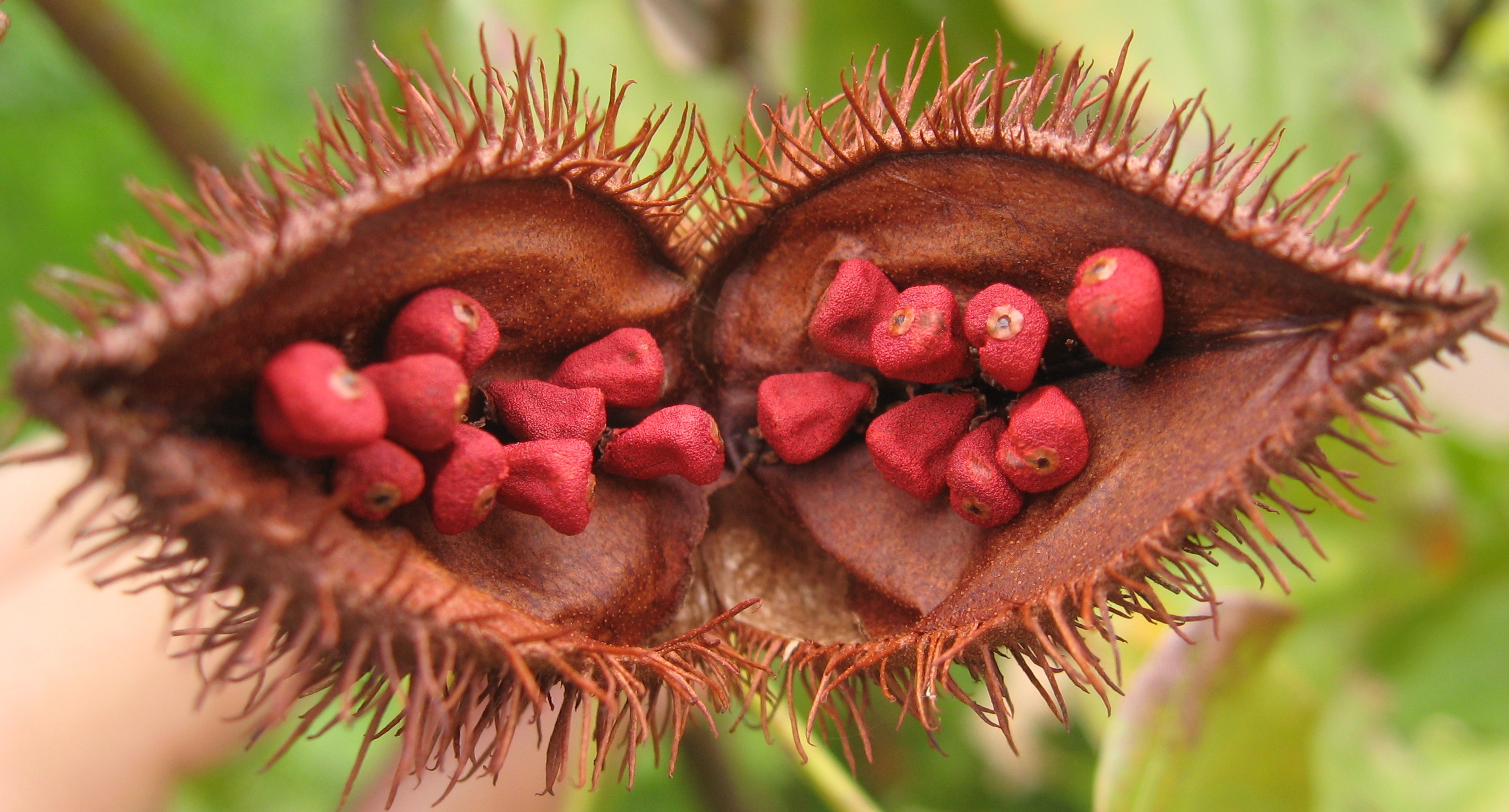
(https://upload.wikimedia.org/wikipedia/commons/6/6a/Bixa_orellana_fruit_open.jpg)
Annato, or achote, is usually used as a natural plant dye or food coloring, and has been used for centuries in Central and South America, and even in parts of Mexico as a paint and medicine.
“Although mostly only the seed paste or seed oil is used commercially today, the rainforest tribes have used the entire plant as medicine for centuries. A tea made with the young shoots is used by the Piura tribe as an aphrodisiac and astringent, and to treat skin problems, fevers, dysentery, and hepatitis. The leaves are used to treat skin problems, liver disease, and hepatitis. The plant has also been considered good for the digestive system. The Cojedes tribe uses an infusion of the flowers to stimulate the bowels and aid in elimination as well as to avoid phlegm in newborn babies. Traditional healers in Colombia have also used annatto as an antivenin for snakebites. The seeds are believed to be an expectorant, while the roots are thought to be a digestive aid and cough suppressant.
Today in Brazilian herbal medicine, a leaf decoction of annatto is used to treat heartburn and stomach distress caused by spicy foods, and as a mild diuretic and mild laxative. It is also used for fevers and malaria, and, topically, to treat burns. Annatto is a common remedy in Peruvian herbal medicine today, and the dried leaves are called achiotec. Eight to ten dried leaves are boiled for 10 minutes in 1 liter of water for this popular Peruvian remedy. One cup is drunk warm or cold 3 times daily after meals to treat prostate disorders and internal inflammation, arterial hypertension, high cholesterol, cystitis, obesity, renal insufficiency, and to eliminate uric acid. This decoction is also recommended as a vaginal antiseptic and wound healer, as a wash for skin infections, and for liver and stomach disorders.” (Rain-tree.com)
Annato is easily found in local markets in Costa Rica, as well as on the farm. We used it with eggs, curries and rice, and its subtle flavor adds a unique twist to any meal.
Chaya:

(http://www.mexconnect.com/photos/8607-chaya-plant-p-original.jpg?1256522431)
Source: Kuti, J.O. and E.S. Torres. 1996. Potential nutritional and health benefits of tree spinach. p. 516-520. In: J. Janick (ed.), Progress in new crops. ASHS Press, Arlington, VA.
Chaya is a leafy green, and when the young leaves are cooked it tastes similar to spinach, but tastier. Chaya is known as a Mayan super food, and has been used by Central Americans and Southern Mexicans for centuries, and much more nutrients then most leafy greens. ” The chaya leaf is especially high in protein (5.7%), crude fiber (1.9%), calcium (199.4 mg/100 g), potassium (217.2 mg/100 g), iron (11.4 mg/100 g), vitamin C (164.7 mg/100 g), and carotene (0.085 mg/100 g). The levels of chaya leaf nutrients, in this study, agree with published reports (Martin and Ruberte 1978; Munsell et al. 1949; Booth et al. 1992) and are two to threefold greater than most edible leafy green vegetables. In terms of the average nutritive value, chaya leaves [14.9] is by far superior to other leafy green vegetables.
Chaya traditionally has been recommended for a number of ailments including diabetes, obesity, kidney stones, hemorrhoids, acne, and eye problems (Diaz-Bolio 1975). Chaya shoots and leaves have been taken as a laxative, diuretic, circulation stimulant, to improve digestion, to stimulate lactation, and to harden the fingernails (Rowe 1994). Like most food plants such as lima beans, cassava, and many leafy vegetables, the leaves contain hydrocyanic glycosides, a toxic compound easily destroyed by cooking.” https://hort.purdue.edu/newcrop/proceedings1996/V3-516.html)
Noni:
Source: WANG Mian-Ying2, Brett J WEST3, C Jarakae JENSEN3, Diane NOWICKI, SU Chen3, Afa K PALU3, Gary ANDERSON University of Illinois College of Medicine, Department of Pathology, 1601 Parkview Avenue, Rockford, IL 61107, USA; 3Department of R & D, Morinda Inc, Provo, Utah 84606, USA (http://www.chinaphar.com/1671-4083/23/1127.htm)
Noni is an alien looking fruit that smells like blue cheese, and is one of Southeast Asia and Central America’s top super foods. On the farm we harvested the smelly fruit and fermented it into a juice, which is the most common way of ingesting it. Some believe there are more health benefits once its fermented. It is commonly used to treat cancer, infection, arthritis, diabetes, asthma, hypertension, pain, skin conditions, and has been used in times of famine to survive. I was also used it as a soap on the farm for my body and hair.
“Noni was the second most popular plant used in herbal remedies to treat various common diseases and to maintain overall good health” (Wang)
“Medicinal use of Noni plant The Polynesians utilized the whole Noni plant in various combinations for herbal remedies. The fruit juice is in high demand in alternative medicine for different kinds of illnesses such as arthritis, diabetes, high blood pressure, muscle aches and pains, menstrual difficulties, headaches, heart disease, AIDS, cancers, gastric ulcers, sprains, mental depression, senility, poor digestion, atherosclerosis, blood vessel problems, and drug addiction. Scientific evidence of the benefits of the Noni fruit Juice is limited but there is some anecdotal evidence for successful treatment of colds and influenza[16]. Allen reported some information on the ethnobotanical properties of Noni. He said that the fruit is used as deobstruent and emmenagogue. This is one of the earliest articles on the medicinal benefits of Noni[17]. Isabel Abbott, a former botanical chemist at the University of Hawaii, stated that, “People are crazy about this plant. They use it for diabetes, high blood pressure, cancer, and many other illnesses”[18]. Bushnell reported that Noni was a traditional remedy used to treat broken bones, deep cuts, bruises, sores, and wounds[19]. Morton gave numerous references for medicinal uses of Noni[12]. In addition, Polynesians are reported to have successfully used Noni to treat breast cancer and eye problems. Joseph Betz, a research chemist in the FDA’s Division of Natural Products, Center for Food Safety and Applied Nutrition, stated that “Morinda citrifolia has been tested for a number of biological activities in animal and anti-microbial studies.” He reports that the dried fruit has smooth muscle stimulatory activity and histaminergic effects[20].” (Wang)
Sacha Inchi:
(https://www.google.com/search?tbm=isch&q=health+benefits+of+sacha+inchi&hl=en&authuser=0#imgrc=OiasXSkwIDiecM%3A)
Source: http://www.sciencedirect.com/science/article/pii/S0308814612003585
Sacha Inchi is a nut that grew all over the farm, and was sun dried, and then lightly roasted to create a perfect, buttery texture. Tristan told me that it was extremely high in protein and natural fats, and we ate it regularly, flavored with the farm curry powder.
“Sacha inchi (SI) oil has a unique fatty acid composition, similar in ω-3 but twice as much ω-6 levels compared to flax. ► Sacha inchi oil showed highest oxidative instability at 65 °C when compared to corn, flax and high oleic sunflower oils. ► Portable handheld mid-infrared spectrometers provided fast and reliable tools to characterize and authenticate SI oils. ► Evaluation of commercial SI oils from Peruvian markets showed some prevalence of adulteration. ► Combining FT-IR spectroscopy with chemometrics has proven to be a great alternative to traditional testing methods.”

(http://www.livingearth.global/wp-content/uploads/2015/03/Sacha_Info.gif)
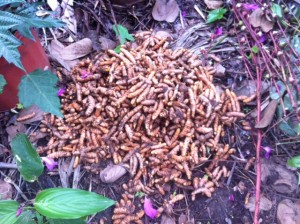
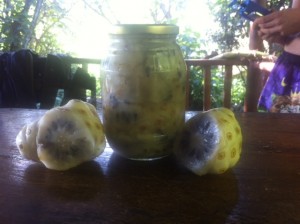

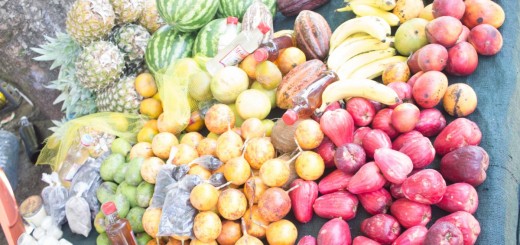
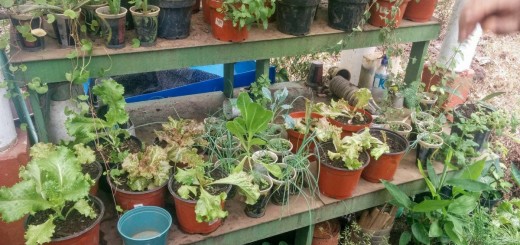
Recent Comments